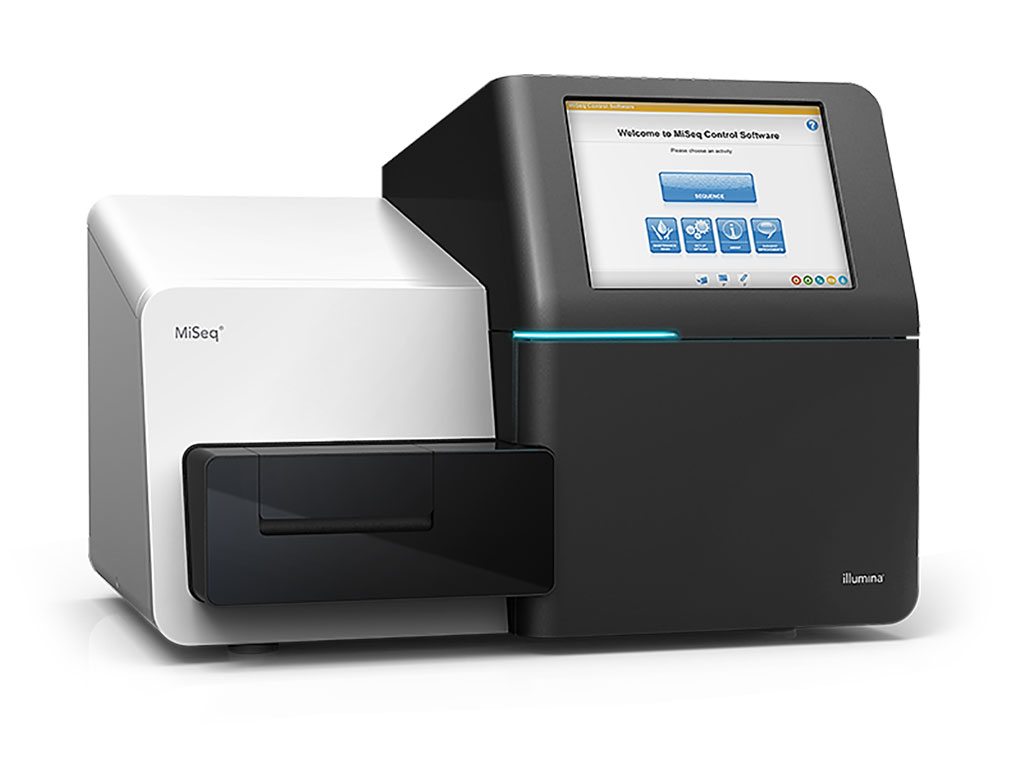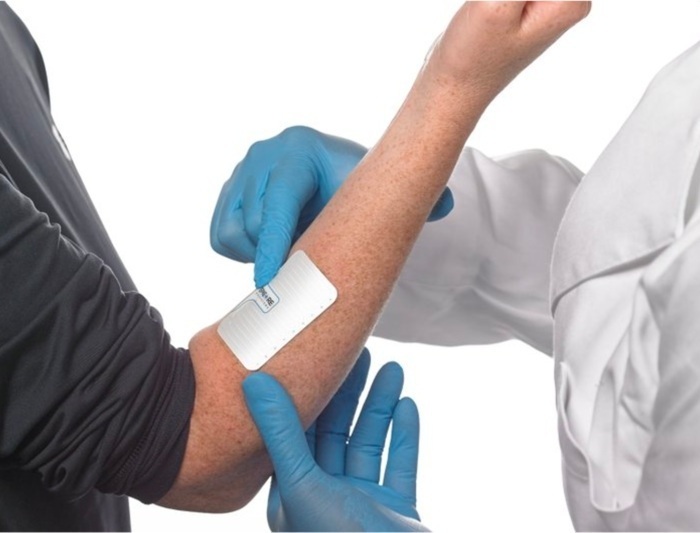Molecular Characterization of Microbiota in Cerebrospinal Fluid Using WGA
|
By LabMedica International staff writers Posted on 02 Sep 2021 |

Image: The MiSeq benchtop sequencer enables targeted and microbial genome applications, with high-quality sequencing, simple data analysis, and cloud storage (Photo courtesy of Illumina)
Hydrocephalus is a common cause of neurological disability in children. Cerebrospinal fluid (CSF) shunt placement allows children with hydrocephalus to survive and avoid ongoing brain injury.
Understanding the etiology of cerebrospinal fluid shunt infections and reinfections requires detailed characterization of associated microorganisms. Traditionally, identification of bacteria present in the CSF has relied on culture methods, but recent studies have used high throughput sequencing of 16S rRNA genes.
Neurosurgeons at the Seattle Children’s Hospital (Seattle, WA, USA) and their colleagues enrolled in a study a subset of children who failed treatment for CSF shunt infection (i.e. had CSF shunt reinfection) and had CSF collected both near the beginning and end of both infection episodes. All samples were tested by routine CSF aerobic culture in hospital-certified laboratories.
DNA was extracted and purified from CSF samples using the AGOWA mag Mini DNA isolation kit (AGOWA, LGC Genomics, Berlin, Germany) and CSF microbiota amplicon library construction was carried out using a one-step PCR amplification targeting the V4 region of the bacterial 16S rRNA gene. Sequencing of the pooled libraries was carried out for 600 cycles on an Illumina MiSeq desktop sequencer using the MiSeq Reagent Kit v3 (Illumina, San Diego, USA). Whole genome amplification (WGA) of DNA purified from CSF samples and two mock community samples was carried out using the REPLI-g Mini Kit (Qiagen, Hilden, Germany) and sequenced on the Illumina HiSeq 2500 platform to produce 96-bp paired-end reads.
Taxonomic assignments of sequences from WGA and 16S were compared with one another and with conventional microbiological cultures. While classification of bacteria was consistent among all the approaches, WGA provided additional insights into sample microbiological composition, such as showing relative abundances of microbial versus human DNA, identifying samples of questionable quality, and detecting significant viral load in some samples. One sample yielded sufficient non-human reads to allow assembly of a high-quality Staphylococcus epidermidis genome, denoted CLIMB1, which we characterized in terms of its multilocus sequence typing (MLST) profile, gene complement (including putative antimicrobial resistance genes), and similarity to other annotated S. epidermidis genomes.
The authors concluded that they had demonstrated that WGA directly applied to CSF is a valuable tool for the identification and genomic characterization of dominant microorganisms in CSF shunt infections, which can facilitate molecular approaches for the development of better diagnostic and treatment methods. The study was published on August 20 2021 in the journal Frontiers in Cellular and Infection Microbiology.
Related Links:
Seattle Children’s Hospital
LGC Genomics
Illumina
Qiagen
Understanding the etiology of cerebrospinal fluid shunt infections and reinfections requires detailed characterization of associated microorganisms. Traditionally, identification of bacteria present in the CSF has relied on culture methods, but recent studies have used high throughput sequencing of 16S rRNA genes.
Neurosurgeons at the Seattle Children’s Hospital (Seattle, WA, USA) and their colleagues enrolled in a study a subset of children who failed treatment for CSF shunt infection (i.e. had CSF shunt reinfection) and had CSF collected both near the beginning and end of both infection episodes. All samples were tested by routine CSF aerobic culture in hospital-certified laboratories.
DNA was extracted and purified from CSF samples using the AGOWA mag Mini DNA isolation kit (AGOWA, LGC Genomics, Berlin, Germany) and CSF microbiota amplicon library construction was carried out using a one-step PCR amplification targeting the V4 region of the bacterial 16S rRNA gene. Sequencing of the pooled libraries was carried out for 600 cycles on an Illumina MiSeq desktop sequencer using the MiSeq Reagent Kit v3 (Illumina, San Diego, USA). Whole genome amplification (WGA) of DNA purified from CSF samples and two mock community samples was carried out using the REPLI-g Mini Kit (Qiagen, Hilden, Germany) and sequenced on the Illumina HiSeq 2500 platform to produce 96-bp paired-end reads.
Taxonomic assignments of sequences from WGA and 16S were compared with one another and with conventional microbiological cultures. While classification of bacteria was consistent among all the approaches, WGA provided additional insights into sample microbiological composition, such as showing relative abundances of microbial versus human DNA, identifying samples of questionable quality, and detecting significant viral load in some samples. One sample yielded sufficient non-human reads to allow assembly of a high-quality Staphylococcus epidermidis genome, denoted CLIMB1, which we characterized in terms of its multilocus sequence typing (MLST) profile, gene complement (including putative antimicrobial resistance genes), and similarity to other annotated S. epidermidis genomes.
The authors concluded that they had demonstrated that WGA directly applied to CSF is a valuable tool for the identification and genomic characterization of dominant microorganisms in CSF shunt infections, which can facilitate molecular approaches for the development of better diagnostic and treatment methods. The study was published on August 20 2021 in the journal Frontiers in Cellular and Infection Microbiology.
Related Links:
Seattle Children’s Hospital
LGC Genomics
Illumina
Qiagen
Latest Molecular Diagnostics News
- Routine Blood Draws Could Detect Epigenetic Biomarkers for Predicting Cardiovascular Disease Risk
- Single Cell RNA Sequencing Could Enable Non-Invasive Blood Disorder Diagnosis
- Blood Test Identifies HPV-Associated Head and Neck Cancers 10 Years Before Symptoms
- Giant DNA Elements Discovered in Mouth Could Impact Oral Health
- Simple Blood Test Spots Disease Through Metabolic Distortion
- Simple Blood Test Could Streamline Early Alzheimer's Detection
- Unique Microbial Fingerprint to Improve Diagnosis of Colorectal Cancer
- ELISA-Based Test Uses Gynecologic Fluids to Detect Endometrial Cancer
- Comprehensive Tumor Profiling Kit Decentralizes and Standardizes Oncology Testing
- Automated Syndromic Testing System Combines Unparalleled Throughput with Simple Workflow
- Simple Urine Test Assesses Risk of Kidney Cancer Recurrence at Early Stage
- Molecular Map Reveals Previously Hidden Connections Between Diseases
- Novel Urine-Based Test Detects Prostate Cancers
- MRD Testing Can Identify Breast Cancer Survivors at Higher Risk of Recurrence
- Cytoskeletal Protein Linked to Cervical Cancer Growth Paves Way for Precise Diagnostic Tools
- Molecular Allergy Chip Detects Allergic Asthma in Individual Patients
Channels
Clinical Chemistry
view channel
Gold Nanoparticles to Improve Accuracy of Ovarian Cancer Diagnosis
Ovarian cancer is considered one of the deadliest cancers, in part because it rarely shows clear symptoms in its early stages, and diagnosis is often complex. Current approaches make it difficult to accurately... Read more
Simultaneous Cell Isolation Technology Improves Cancer Diagnostic Accuracy
Accurate cancer diagnosis remains a challenge, as liquid biopsy techniques often fail to capture the complexity of tumor biology. Traditional systems for isolating circulating tumor cells (CTCs) vary in... Read moreHematology
view channel
Pioneering Model Measures Radiation Exposure in Blood for Precise Cancer Treatments
Scientists have long focused on protecting organs near tumors during radiotherapy, but blood — a vital, circulating tissue — has largely been excluded from dose calculations. Each blood cell passing through... Read more
Platelets Could Improve Early and Minimally Invasive Detection of Cancer
Platelets are widely recognized for their role in blood clotting and scab formation, but they also play a crucial role in immune defense by detecting pathogens and recruiting immune cells.... Read more
Portable and Disposable Device Obtains Platelet-Rich Plasma Without Complex Equipment
Platelet-rich plasma (PRP) plays a crucial role in regenerative medicine due to its ability to accelerate healing and repair tissue. However, obtaining PRP traditionally requires expensive centrifugation... Read moreImmunology
view channel
Companion Diagnostic Test Identifies HER2-Ultralow Breast Cancer and Biliary Tract Cancer Patients
Breast cancer is the most common cancer in Europe, with more than 564,000 new cases and 145,000 deaths annually. Metastatic breast cancer is rising in younger populations and remains the leading cause... Read more
Novel Multiplex Assay Supports Diagnosis of Autoimmune Vasculitis
Autoimmune vasculitis and related conditions are difficult to diagnose quickly and accurately, often requiring multiple tests to confirm the presence of specific autoantibodies. Traditional methods can... Read more
Blood Test Predicts Immunotherapy Efficacy in Triple-Negative Breast Cancer
Triple-negative breast cancer (TNBC) is an aggressive subtype lacking targeted therapies, making immunotherapy a promising yet unpredictable option. Current biomarkers such as PD-L1 expression or tumor... Read more
Simple Genetic Testing Could Predict Treatment Success in Multiple Sclerosis Patients
Multiple sclerosis (MS) patients starting therapy often face a choice between interferon beta and glatiramer acetate, two equally established and well-tolerated first-line treatments. Until now, the decision... Read moreMicrobiology
view channel
Microfluidic Platform Assesses Neutrophil Function in Sepsis Patients
Sepsis arises from infection and immune dysregulation, with neutrophils playing a central role in its progression. However, current clinical tools are unable to both isolate these cells and assess their... Read moreNew Diagnostic Method Confirms Sepsis Infections Earlier
Sepsis remains one of the most dangerous medical emergencies, often progressing rapidly and becoming fatal without timely intervention. Each hour of delayed treatment in septic shock reduces patient survival... Read more
New Markers Could Predict Risk of Severe Chlamydia Infection
Chlamydia trachomatis is a common sexually transmitted infection that can cause pelvic inflammatory disease, infertility, and other reproductive complications when it spreads to the upper genital tract.... Read more
Portable Spectroscopy Rapidly and Noninvasively Detects Bacterial Species in Vaginal Fluid
Vaginal health depends on maintaining a balanced microbiome, particularly certain Lactobacillus species. Disruption of this balance, known as dysbiosis, can increase risks of infection, pregnancy complications,... Read morePathology
view channelAccurate Pathological Analysis Improves Treatment Outcomes for Adult Fibrosarcoma
Adult fibrosarcoma is a rare and highly aggressive malignancy that develops in connective tissue and often affects the limbs, trunk, or head and neck region. Diagnosis is complex because tumors can mimic... Read more
Clinicopathologic Study Supports Exclusion of Cervical Serous Carcinoma from WHO Classification
High-grade serous carcinoma is a rare diagnosis in cervical biopsies and can be difficult to distinguish from other tumor types. Cervical serous carcinoma is no longer recognized as a primary cervical... Read moreTechnology
view channel
Coral-Inspired Capsule Samples Hidden Bacteria from Small Intestine
The gut microbiome has been linked to conditions ranging from immune disorders to mental health, yet conventional stool tests often fail to capture bacterial populations in the small intestine.... Read more
Rapid Diagnostic Technology Utilizes Breath Samples to Detect Lower Respiratory Tract Infections
Respiratory tract infections (LRTIs) are leading causes of illness and death worldwide, particularly among vulnerable populations such as the elderly, young children, and those with compromised immune systems.... Read moreIndustry
view channel
Werfen and VolitionRx Partner to Advance Diagnostic Testing for Antiphospholipid Syndrome
Antiphospholipid syndrome (APS) is a rare autoimmune disorder that causes the immune system to produce abnormal antibodies, making the blood “stickier” than normal. This condition increases the risk of... Read more



















